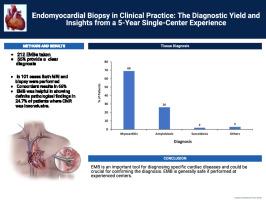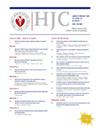临床实践中的心内膜心肌活检:心内膜心肌活检在临床实践中的应用:五年单中心经验的诊断率和启示。
IF 3
3区 医学
Q2 CARDIAC & CARDIOVASCULAR SYSTEMS
引用次数: 0
摘要
背景和目的:心内膜活检(EMB)是评估心肌炎和心肌浸润性疾病等各种心脏疾病的诊断工具。它也是检测心脏移植后异体移植排斥反应的金标准筛查技术。尽管用于心肌组织特征描述的无创成像模式不断进步,但 EMB 仍是明确诊断和确定某些疾病治疗方法的必要手段。在此,我们报告了最近使用 EMB 的经验及其诊断结果:我们回顾性审查了我院自 2018 年 3 月至 2023 年 3 月期间进行的 EMB。我们收集了临床数据,包括患者特征、EMB 的适应症和诊断率以及手术相关并发症。记录活检组织病理学结果,并根据其与临床诊断和心脏磁共振成像(CMR)结果的匹配程度进行分类。对178名连续患者的212例EMB进行了回顾性分析,其中42例活检用于监测异体移植排斥反应(10名患者),其余活检用于推测诊断急性心肌炎或原因不明的心肌病。在非心脏移植病例中,54.7%的心肌活检提供了明确诊断。最常见的诊断是心肌炎(69%),其次是心脏淀粉样变性(CA)(26%)。EMB 还有助于发现几种罕见的心脏疾病,如嗜酸性粒细胞肉芽肿伴多血管炎(EGPA)、法布里病和心脏肉样瘤病。在一组同时接受 CMR 和 EMB 检查的 101 名患者中,66% 的病例结果一致。然而,在 24.7% 的患者中,EMB 能够确定 CMR 结果不确定的病理情况,这突出了其在确定准确诊断方面的补充作用。在已进行的212例EMB中,无一例出现并发症:结论:随着心脏成像技术的发展,EMB 已不再是诊断心肌病的常规方法。然而,EMB 仍是诊断特定心脏疾病的重要工具,对确诊至关重要。如果在经验丰富的中心进行,EMB 一般是安全的。本文章由计算机程序翻译,如有差异,请以英文原文为准。

Endomyocardial biopsy in clinical practice: the diagnostic yield and insights from a 5-year single-center experience
Objectives
Endomyocardial biopsy (EMB) is a diagnostic tool for evaluating various cardiac conditions, such as myocarditis and myocardial infiltrative diseases. It is also the gold standard screening technique for detecting allograft rejection after heart transplantation. Despite advances in noninvasive imaging modalities for myocardial tissue characterization, EMB is still necessary for making a definitive diagnosis and determining treatment for certain conditions. Herein, we report our recent experience using EMB and its diagnostic yield.
Methods and Results
We retrospectively reviewed EMBs performed at our institution from March 2018 through March 2023. Clinical data, including patient characteristics, indication and diagnostic yield of EMB, and procedure-related complications, were collected. Histopathological findings of the biopsies were recorded and classified based on the degree to which they matched the clinical diagnosis and cardiac magnetic resonance imaging (CMR) findings. A total of 212 EMBs obtained in 178 consecutive patients were retrospectively analyzed, with 42 biopsies performed for allograft rejection surveillance (10 patients) and the remaining performed for presumptive diagnosis of acute myocarditis or unexplained cardiomyopathy. Among the non-heart transplant cases, 54.7% of EMBs provided a clear diagnosis. The most common diagnosis was myocarditis (69%), followed by cardiac amyloidosis (CA) (26%). EMB was also helpful in detecting several rare cardiac conditions, such as eosinophilic granulomatosis with polyangiitis (EGPA), Fabry disease, and cardiac sarcoidosis. In a cohort of 101 patients who underwent both CMR and EMB, the results were concordant in 66% of cases. However, in 24.7% of patients, EMB was able to identify pathological conditions where CMR results were inconclusive, highlighting its complementary role in determining an accurate diagnosis. No complications were reported in any of the 212 EMBs performed.
Conclusions
With advances in cardiac imaging modalities, EMB is not routinely indicated for the diagnosis of cardiomyopathy. However, EMB is still an important tool for diagnosing specific cardiac diseases and could be crucial for confirming the diagnosis. EMB is generally safe if performed at experienced centers.
求助全文
通过发布文献求助,成功后即可免费获取论文全文。
去求助
来源期刊

Hellenic Journal of Cardiology
CARDIAC & CARDIOVASCULAR SYSTEMS-
CiteScore
4.90
自引率
7.30%
发文量
86
审稿时长
56 days
期刊介绍:
The Hellenic Journal of Cardiology (International Edition, ISSN 1109-9666) is the official journal of the Hellenic Society of Cardiology and aims to publish high-quality articles on all aspects of cardiovascular medicine. A primary goal is to publish in each issue a number of original articles related to clinical and basic research. Many of these will be accompanied by invited editorial comments.
Hot topics, such as molecular cardiology, and innovative cardiac imaging and electrophysiological mapping techniques, will appear frequently in the journal in the form of invited expert articles or special reports. The Editorial Committee also attaches great importance to subjects related to continuing medical education, the implementation of guidelines and cost effectiveness in cardiology.
 求助内容:
求助内容: 应助结果提醒方式:
应助结果提醒方式:


